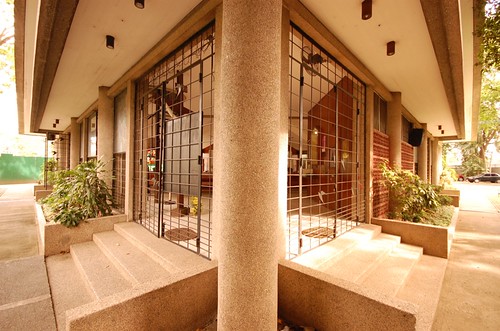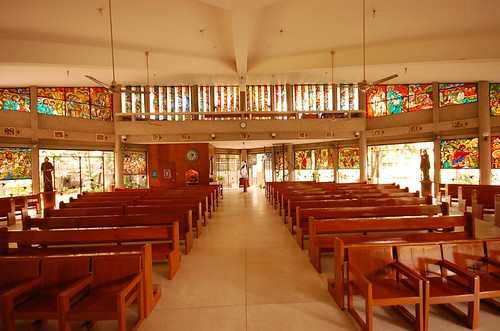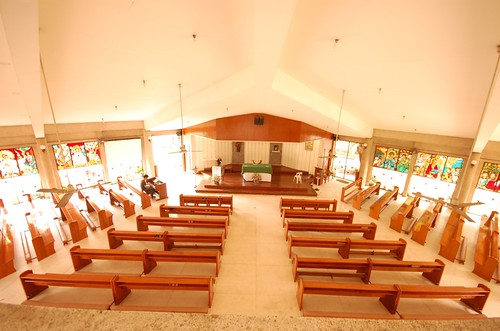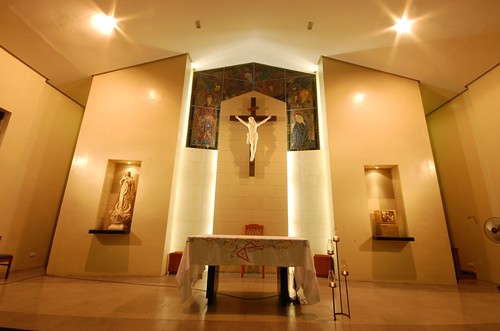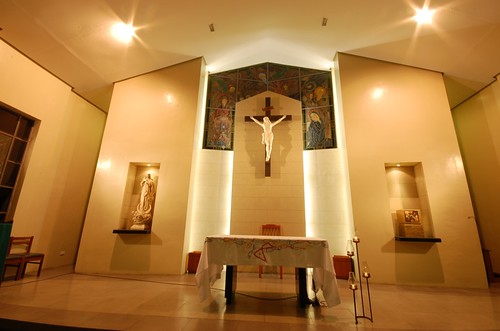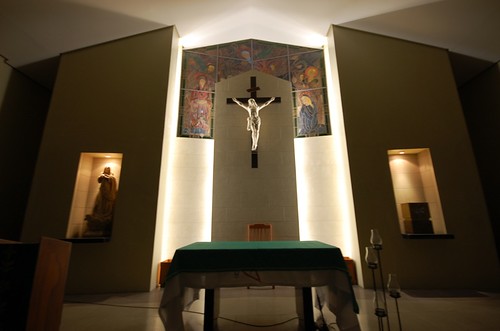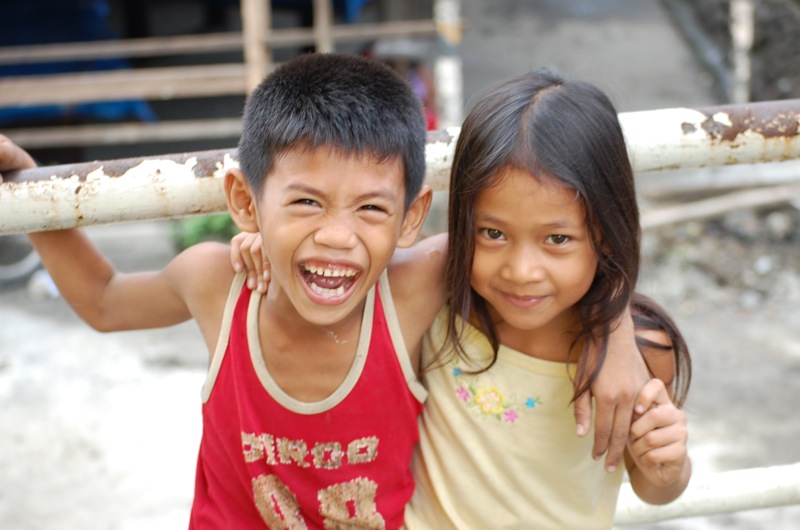Friday, October 24, 2008
Thursday, October 23, 2008
Tuesday, October 21, 2008
Correct University Seal
 Due to proliferation of wrong seal (logo) of Ateneo de Davao University, I am posting the correct seal. Here is the description of the seal (www.addu.edu.ph):
Due to proliferation of wrong seal (logo) of Ateneo de Davao University, I am posting the correct seal. Here is the description of the seal (www.addu.edu.ph):"The two top panels of the shield represent Davao. The gold and silver inverted crossed keys against a light blue background represent St. Peter, patron of Davao parish church (now Cathedral). The light blue background represents Our Lady, patroness of the Philippines and of the Ateneo de Davao University (under the title of the Assumption of Our Lady). The green mountain peaks in the other panel represent Mt. Apo and its neighboring peaks, clearly visible from Davao City.
The two lower panels of the shield are the family arms of the founder of the Society of Jesus, St. Ignatius of Loyola of the House of Onaz y Loyola. The seven red and gold stripes represent the seven sons of the House of Onaz who fought under their king for the liberties of the Christians in Spain. The wolves-and-pot (lobos y olla) are a pun on the family name Loyola.
The crest above the shield is a silver medallion containing the monogram of the Society of Jesus: IHS are the first three letters of the name Jesus in Greek; the cross and the nails recall His passion and death as savior of mankind. The Latin motto “Fortes in Fide” (“Strong in the Faith") is from 1 Peter 5, 9. It is also the burden of a passage from St. Paulʼs letter to the Ephesians: Eph. 5, 10-20."
Here are the wrong seals (logos), some of which are perpetuated by the printing press agencies which keep on printing them wrongly (which brings me to a thought of contemplating legal action against them for printing and using the it without permission from the University, and worst having it all wrong):

Wrong Seal

Wrong Seal (8 golden stripes); fonts are wrong

Wrong Seal; Stripes lacking; the pot looks like a ball

Wrong Seal
Monday, October 20, 2008
Friday, October 17, 2008
Naya and the Hope for Life
Three months ago, her doctors gave her parents three months to raise the money for her bone marrow transplant. Three months have passed and now she badly needs the transplant. Her parents are desperately seeking for help, financial or otherwise. They need 3 million pesos to make the bone marrow transplant possible.
Any help will be greatly appreciated.


Wednesday, October 15, 2008
Bankerohan Shoot
Anybody interested to come should contact Marvin and Emery for details (time/ place to meet up). I think the shoot starts at 5:30AM until 6:30AM.
See sample shots of Mayen Shutterbug and Blue Iguana. I like the vibrant colors and the Bankerohan busy life.
Thursday, October 09, 2008
Donate your Calories: Halika! Davao

HALIKA! DAVAO
Mag-Healthy and Active Living Na!
The Ateneo de Davao University invites you to
join the Nationwide Charity Workout of Coca-Cola and help
transform lives one calorie at a time. Get into fun and easy
moves inspired by your day-to-day activities and learn more
about the importance of regular physical activity,
balanced nutrition and proper hydration.
For every calorie that you burn in the free workout sessions,
Coca-Cola donates one peso (P1.00) to
Feed the Children Philippines, Inc.
So help out by sweating it out on
October 11, 2008 at the Rizal Park Grounds.
Registration starts at 6AM. No Registration Fee.
Please come in proper exercise attire.
Free drinks and t-shirts await workout participants.
For further details, contact the
Social Involvement Coordinating Office (SICO)
at (82) 221.2411 local 8329
Ateneo de Davao University


Tuesday, October 07, 2008
Atenista Survey (Grabbed from Mick B.)
1. Student number?
-->10159A
2. College?
--> School of Arts and Sciences
3. Ano ang course mo?
--> AB Pre-Divinity
4. Nag-shift ka ba o na-kickout?
--> Nope.
5. Saang Ateneo ka nag-aaral?
-- Manila.
6. Favorite subject/s?
--> MAJOR: Philo of Human Person, Greek Philosophy, Philo of Religion, Old Testament, Hypnotherapy, Psychological Experiments, Biology, Microeconomics, Liberation Theology, Spanish, Philippine History
--> MINOR: Physics, Filipino
7. Favorite PE?
--> Mountain Climbing
8. Saan ka nag-aabang ng hot girl sa school?
--> Sa Caf, and sa Colayco Hall (wala na ngayon)
9. Favorite prof(s)
Fr. Roque J. Ferriols S.J. (my mentor/ teacher for my six philo subjects)Fr. Victor Salanga S.J. (teacher for Old Testament)
Fr. Nicasio Cruz S.J. (teacher for my Film Theory/ Film Apps / Sex and Violence in Film Classes
Fr. Joel Tabora S.J. (my mentor on photography, German Language and Marx)
Mr. Pancho Escaler (my teacher in photography)
Senora Torres (my teacher of 4 Spanish courses - 4 sems!)
Dr. Rainier Ibana (my teacher/ mentor on Juergen Habermas)
Dr. Ramon Reyes (teacher for my Modern Philosophy class)
Fr. Bill Abbott S.J. (teacher for my New Testament class)
Fr. O'Shaughnessy S.J (teacher for my Logic)
Mr. Henry Totanes (my Phil History teacher - my best history class)
Fr. Bartholomew Lahiff (my Western Civilization teacher)
Fr. Joe Cruz S.J. (my Pre-Colonial History teacher)
Mr. Bobby O. Guervarra (my teacher for my Liberation Theology class)
Bro. Yago (the best Biology teacher)
10. Pinaka-ayaw na subject/s.
--> Anthropology (puro lang panood ng play sa CCP)
11. Kumuha ka ba ng Wed or Sat classes?
--> Yes. ROTC - Air Force!
12. Nakapag-field trip ka ba?
--> Ilang beses na! Luzon,
13. Naging active ka ba sa school?
--> Yes. I need, like and want to.
14. Ano ang Org/Frat/Soro mo?
--> Musmos (street children apostolate), ACIL, ACMG
15. Saan ka tumatambay palagi?
--> Musmos Office / Library/ Philo Dept/ Dorm/ Sanjo
16 Dorm, Boarding house, o Bahay?
--> Dorm.
17. Nag-ACAT ka ba?
--> ACET po. Ateneo College Entrance Test.
18. Sino ang pinaka-una mong nakilala sa Ateneo?
--> Haha.... si Kris Aquino at Lea Salonga. Haha, joke. - Vic Dugan from Sorsogon, now with San Miguel Foundation.
19. First play na napanood mo sa Ateneo?
--> Sinta, Ang Paglilitis ni Mang Serapio
20. Name the 5 most conyo orgs in Ateneo.
urhmmmGUIDON
AIESEC
AIESEC
AIESEC
AIESEC
21. Name the coolest orgs/frats/soro in Ateneo.
MUSMOSATSCA
KAINGIN
MATANGLAWIN
22. May frat/soro bang nag-recruit sa yo?
--> Wala.
23. Saan ka madalas mag-lunch?
--> Caf, Covered Court, Full House, Mongolian BBQ, Sanjo
24. Masaya ba sa Ateneo?
-- Super!
25. Nakasama ka na ba sa rally?
--> Maraming beses. Lalo na sa kudeta - organizer ako sa rally/ marshall
26. Ilang beses ka bumoto sa Student Council?
--> Apat na beses --- di ba isa lang sa isang taon ang election?
27. Name at least 5 leftist groups in Ateneo.
--> Haha. Secret yan.
28. Kung di ka sa Ateneo, anong school ka?
--> Silliman University (Bio) / WVSU (Bio)
Grabbed from Mick Basa. =)
Cycle Pit Stop
A community for developing and uniting
the next generation of principle-centered leaders
WEEKLY WISDOM:
IT'S NOT THE MILK THAT'S SPOILED!
Dear Youth, (the young ones and the young once!)
You've heard about the Chinese milk scandal. But think about this for a moment. What could be the connection between Chinese milk, unstable oil prices and the US economic crisis? As you read through the short descriptions of these events, see if you can find patterns in how some people think...
Got Milk: Why do people put melamine in milk even when they know it's toxic? Because melamine makes milk appear to have more protein by increasing the milk's nitrogen levels. So some companies use it to fool government quality tests and make their products more marketable. The contaminated milk has already afflicted more than 50,000 children. This is the third product scandal in China in the last 15 months. Last year, some Chinese toy companies were found guilty of using paint that contained high levels of lead, which is also very toxic. These companies used lead paint to lower their costs of production and make their toys appear glossier. Prior to that, we heard about people selling dumplings filled with cardboard. Hmmm...
It might seem very tempting to judge the Chinese people and look down on them for disregarding ethical business practices. But look at what's happening in other parts of the world...
Oily Bubbles: How did the price of oil reach so high so suddenly? Although there are many factors, a major contributing factor to the oil price bubble is oil speculation. An oil speculator is someone who purchases oil stocks, anticipates oil prices, and then resells the stocks at higher prices. Oil speculation causes prices to increase by artificially increasing demand. The real demand is actually much lower, but oil speculators keep demand high by trading among themselves, then selling the stocks at higher prices, thus making a profit for themselves while everyone else pays more than they should. These oil speculators are found all over the world...
Selling it Short: Why did the US government ban short selling in the stock market? One of the interventions to address the US economic crisis was to temporarily ban short selling. Short selling is similar to speculation in that it can also manipulate the market; but instead of betting on prices to rise, short sellers bet on prices to go down and then profit from it. For example, a short seller can make money simply by "borrowing" 100 stocks and selling them at 2$ in the morning, then buying these back later in the day for 1$ and returning them to the owner. Short sellers profit when stocks drop. So with the current crisis, it really doesn't help when you have people betting on you to lose and making money when people lose. But even without the crisis, short selling offers no real economic benefits to anyone other than the people making the trades.
So, what patterns did you see?
Even in cultures with supposedly high ethical standards, people with selfish interests still find ways to fill their pockets. They might use different strategies, but the troubling patterns are the same. It's just a case of different names for the same thing.
Greed. Deception. Desire for immediate gratification. Going for short term gains at the expense of long term stability. Profiting at the expense of others. Acting for oneself alone without considering how it affects the big picture.
At the end of the day, it's not the milk that's spoiled...it's the people.
The best thing about being youthful is having the power to recreate and rejuvenate. To rejuvenate means to give new life and vigor, and to restore something spoiled to a brand new state.
Did you know that 'Juve' literally means youth? It almost seems that, as youth, we are meant to keep the hope for change alive. Perhaps, if we care enough, we can be the generation that breaks the old patterns and creates new ones.
All the best,
the CYCLE Team
Monday, October 06, 2008
Scholarships
- Netherlands Fellowship Programme (NFP)
- Scholarships opportunites at Utrecht University
- SCHOLARSHIP FOR POST-GRADUATE STUDIES IN MALAYSIA
- Swedish Institute scholarships
- Oxford and the Rhodes Scholarships
- The Google Europe Anita Borg Memorial Scholarship 2009
- Government of Canada Awards Program
- Canadian Commonwealth Scholarship Program
- Scholarships Opportunities in Monash University - Australia
- International Scholarships Opportunities at Axford University- UK
- Various Scholarships for Studies in New Zealand
- UNEP Master's Scholarships in AIT- Thailand
- Vacant PhD positions, Surface Technology & Tribology group, Dept of Engineering Technology, Univ of Twente, the Netherlands
- Doctoral Scholarship - New Zealand
- PhD Scholarships, University of Victoria, New Zealand
- Endeavour Research Fellowships - Australia
- Sida's scholarships - SWEDEN
- STINT Scholarship for Academic Excellence - SWEDEN
- A mbassadorial Scholarships fromThe Rotary Foundation
- Scholarships for Ph.D. at a Flemish university, Belgium
- Swiss government grants and scholarships for foreign students and artists
- Scholarships for IT Master Programs University of Copenhagen- Denmark
- CIMO Fellowships - FINLAND
- The Guest Scholarship Program - Swedish Universities
- PhD scholarships in Bioinformatics several Australian Universities
- Study in Switzerland - Get a Scholarship
- Scholarships for IT at Information and Communication Technology, Korea
- Scholarships in oceanic fluid dynamic at Memorial University Newfoundland, Canada
- Studentships at Trinity College Dublin, Ireland
- Study in Sweden - Master Programme for Key Personnel in Developing Countries
- MPhil/PhD Studentships, King's College London, UK
- Grants for Master and PhD Students in Bonn Graduate School of Economics-Germany
- Ericsson Master Scholarships in Wireless Systems at KTH Stockholm-Sweden
- Master Scholarships 2008 at Carnegie Mellon Heinz School, Adelaide-Australia
- Ambassadorial Scholarships- Worldwide
- New Zealand International Scholarships
- Postgraduate Scholarships in Greece
- Scholarships at The IT University of Copenhagen (ITU)- Denmark
- Scholarships by The Korea Institute of Science and Technology (KIST)
- Scholarship at University Sport Birmingham (USB), UK
- Master Scholarships at ENS Lyon- France
- M.Sc. Programme in Public Health, Maastricht University, The Netherland
- Ambassadorial Scholarships- Worldwide
Junior Research Fellowships -Trinity College Cambridge, UK - The International Centre of Excellence in Tourism and Hospitality Education Scholarship - Australia
- Swiss scholarships for university studies
- CIMO Fellowships -Finland
- AYF Fellowship-JAPAN (2007)
- International Fellowship Scholarship Program for Women - USA
- Ph.D.-student position in the Solid State Physics - U twente, NL
- PhD Studentship Institute of Petroleum Engineering -UK
- CIMO Fellowships -Finland
- AYF Fellowship-JAPAN (2007)
- NAEd Postdoctoral Fellowship
- PhD Scholarship Flinders University Australia
- New Zealand Development Scholarships
- Swedish Institute scholarships
- Ford Foundation International Fellowships Program
- VLIR Scholarships (2007-2008)- Belgium
- John Henry Brookes International Scholarships, UK
- PhD Position at University of Twente, The Netherlands
- PhD in Cryptographic Protocols-Bochum- Germany
- PhD in Morphogenesis- EMBL Heidelberg, Germany
- PhD Student, McGill University, Canada
- PhD Fellowships at University of Padova, Italy
- PhD Studentship in Chemical Engineering at NTUST, Taiwan
- ABBEST PhD Research Scholarships, Ireland
- Graduate Student Position at KTH, Sweden
- PhD in Numerical Analysis and Applications in Finance, Norway
- PhD felllowship at FMI, Basel, Swiss
- Scholarships in Business and Economics--Humboldt -Universitat, Germany
- Research Grants in Oceanography and Experimental Geophysics- Italy
- Neurolinguistics: PhD Student, McGill University, Canada
- Asian Development Bank - Japan Scholarship Program
- New Admission at JGSEE-Bangkok
- The SEASREP Grant (for promoting Southeast Asian studies )
- PhD Positions at The International Max Planck Research School for Molecular and Cellular Life Sciences
- East-West Center Graduate Degree Fellowship Program 2007
- Wageningen University ,The Netherlands - PhD positions
- PhD Scholarships- Politecnico di Milano, Italy
- Research grant from ISF
- Scholarship possibilities- Ghent University, Belgium
- Asian Development Bank - Japan Scholarship Program
- RSM Fellowships Program -World Bank
- PHD STUDENTSHIPS IN COMPUTATIONAL LINGUISTICS, SPEECH TECHNOLOGY, University of Edinburg-UK
- PhD positions in Optics and Photonics-ICFO, Spain
- PhD Scholarship, Stockholm University-Sweden
- PhD Scholarship in Civil Engineering- Univ. of Strathclyde- UK
- Study and Scholarships at The Joint Graduate School of Energy and Environtment- Thailand
- Asian Youth Fellowship-JAPAN
- Doctoral Research Studentships- New Zealand
- Postgraduate Research in Chemistry - Herriot Watt University
- Various Scholarships at Monash University-Australi a
- Government of Canada Awards to foreign students for graduate study in Canada
- PhD scholarships in Optics and Photonics-Spain
- The Luisa Mallari Fellowships for M.A./Ph.D. Research in Southeast Asian Studies
- Utrecht Excellence Scholarships 2006-2007 -Netherlands
- Trust Jourdain Scholarship- for Masters and Doctoral Studies
- PhD Studentship in Biomedical Sciences at Univ. of Birmingham-UK
- PhD Position in Biomedical Signal Processing-Chalmers Univ.-Sweden
- PhD Studentship in Economics/Business -Universiteit van Amsterdam, The Netherland
- PhD Scholarships- University of Vienna-Austria
- University of Liverpool Management School - Studenships Info
- PhD Scholarships at the University of Kuopio-Finlad
- International Doctoral Scholarships in Information and Comunication: Italy
- Research Fellowship in Management University of Stavanger-Norway
- PhD scholarships in Economics and Business: Universiteit van Amsterdam
- Master Scholarships at University of Liverpool-UK
- PhD scholarships in Finance- Melbourne, Australia
- Various Scholarships at The University of Bat
Saturday, October 04, 2008
What is Melamine

Melamine is an organic compound that is often combined with formaldehyde to produce melamine resin, a synthetic polymer which is fire resistant and heat tolerant. Melamine resin is a very versatile material with a highly stable structure. Uses for melamine include whiteboards, floor tiles, kitchenware, fire retardant fabrics, and commercial filters. Melamine can be easily molded while warm, but will set into a fixed form. This property makes it ideally suited to certain industrial applications.
Melamine resin is manufactured by mixing urea with formaldehyde under heat and pressure. The substances begin to polymerize and are forced into a mold which will create the desired shape. Under pressure, melamine releases water, which could make the plastic unstable if it is not removed. The materials finish polymerizing and create a finished product, melamine resin.
Melamine resin is known as a thermoset plastic, because the plastic is fixed after molding. If exposed to enough heat, melamine will melt. For this reason, melamine dishware should not be exposed to high temperatures like those in the oven and microwave. However, the plastic is able to withstand higher temperatures than other plastics. Because it is a thermoset plastic, melamine resin is difficult to recycle.
Melamine can be made into a foam product. Melamine foam has a distinctive structure composed of stacked bubble shapes, which are extremely hard and therefore can easily clean a wide variety of substances. Melamine foam is marketed under a variety of commercial names including Magic Eraser, a cleaning tool well known for removing scuffs and dirt from a wide range of surfaces.
Melamine resin is used in Formica and similar construction products made from composite materials. Formica is made using melamine resin, which is used to coat the fibers in the upper layer of the construction product. The melamine resin makes the end result heat resistant, so that hot objects can be set on the counter without concern. The surface of the material is designed to be easily wiped and cleaned, creating a long lived household product.
Melamine also plays a role in a wide range of flame resistant materials. These include textiles used in upholstery and the uniforms worn by firemen. Thermal liners, heat resistant gloves, and aprons to protect from splashback of hot substances are made using melamine. Melamine will protect a wearer from heat hazards, and will help to resist the spread of fire in aircraft and buses by providing a fire blocker.
Melamine is also used in the manufacture of some filters. The material is porous and will admit substances to pass through, but can be used to filter out particles of a particular size. Melamine filters are capable of handling a high capacity and can be used in hot environments due to the heat resistance of melamine. Melamine filters are also extremely efficient.
Aside from common commercial uses, melamine became a topic of much discussion in early 2007, when veterinary scientists determined it to be the cause of hundreds of pet deaths, because of pet food contamination. Prior to these reports, melamine had been regarded as non-toxic or minimally toxic. However, because of the unexplained presence of melamine in wheat gluten added to mass-produced dog and cat foods, it is the most likely cause. Pet owners report symptoms that are commonly associated with renal failure, which could be explained by the ammonia that may result from the digestion of the melamine.
In September 2008, several companies were implicated in a scandal involving milk and infant formula which had been adulterated with melamine, leading to kidney stones and other renal failure, especially among young children. By 22 September, nearly 53,000 people had become ill, with more than 12,800 hospitalizations and four infant deaths.
Melamine may have been added to fool government protein content tests after water was added to fraudulently dilute the milk. Because of melamine's high nitrogen content, it can cause the protein content of food to appear higher than the true value.[41][42] Officials estimate that about 20 percent of the dairy companies tested in China sell products tainted with melamine.
2008 Detection of melamine in "White Rabbit" candy
In September 2008, tests by the Connecticut Agriculture Experiment Station Laboratory determined that "White Rabbit Creamy Candy", imported from China, contains melamine.Detection of melamine in food
Until the 2007 pet food recalls, melamine had not routinely been monitored in food, except in the context of plastic safety or insecticide residue. This could be due to the previously assumed low toxicity of melamine, and the relatively expensive methods of detection.
Because melamine resin is often used in food packaging and tableware, melamine at ppm level (1 part per million) in food and beverage has been reported due to migration from melamine-containing resins. Small amounts of melamine have also been reported in foodstuff as a metabolite product of cyromazine, an insecticide used on animals and crops.
Synthesis
Melamine was first synthesized by the German chemist Justus von Liebig in 1834. In early production, first calcium cyanamide is converted into dicyandiamide, then heated above its melting temperature to produce melamine. However, today most industrial manufacturers use urea in the following reaction to produce melamine:
- 6 (NH2)2CO → C3H6N6 + 6 NH3 + 3 CO2
It can be understood as two steps.
First, urea decomposes into cyanic acid and ammonia in an endothermic reaction:
- 6 (NH2)2CO → 6 HCNO + 6 NH3
Then, cyanic acid polymerizes to form melamine and carbon dioxide:
- 6 HCNO → C3H6N6 + 3 CO2
The second reaction is exothermic but the overall process is endothermic.
The above reaction can be carried out by either of two methods: catalyzed gas-phase production or high pressure liquid-phase production. In one method, molten urea is introduced onto a fluidized bed with catalyst for reaction. Hot ammonia gas is also present to fluidize the bed and inhibit deammonization. The effluent then is cooled. Ammonia and carbon dioxide in the off-gas are separated from the melamine-containing slurry. The slurry is further concentrated and crystallized to yield melamine.Major manufacturers and licensors such as DSM, BASF and Eurotecnica have developed some proprietary methods.
The off-gas contains large amounts of ammonia. Therefore melamine production is often integrated into urea production which uses ammonia as feedstock.
Crystallization and washing of melamine generates a considerable amount of waste water, which is a pollutant if discharged directly into the environment. The waste water may be concentrated into a solid (1.5-5% of the weight) for easier disposal. The solid may contain approximately 70% melamine, 23% oxytriazines (ammeline, ammelide and cyanuric acid), 0.7% polycondensates (melem, melam and melon).
Recent production of melamine in mainland China
Between the late 1990s and early 2000s, both consumption and production of melamine grew considerably in mainland China. In the United States Geological Survey 2004 Minerals Survey Yearbook, in a report on worldwide nitrogen production, the author stated that "(mainland) China continued to plan and construct new ammonia and urea plants using coal gasification technology."
By early 2006, melamine production in mainland China is reported to be in "serious surplus". In April 2007, DSM's melamine industry update painted a grave global picture. Between 2002 and 2007, while the global melamine price remained stable, a steep increase in the price of urea (feedstock for melamine) has reduced the profitability of melamine manufacturing. Currently, China is the world's largest exporter of melamine, while its domestic consumption still grows by 10% per year. However, reduced profit has already caused other joint melamine ventures to be postponed there.
